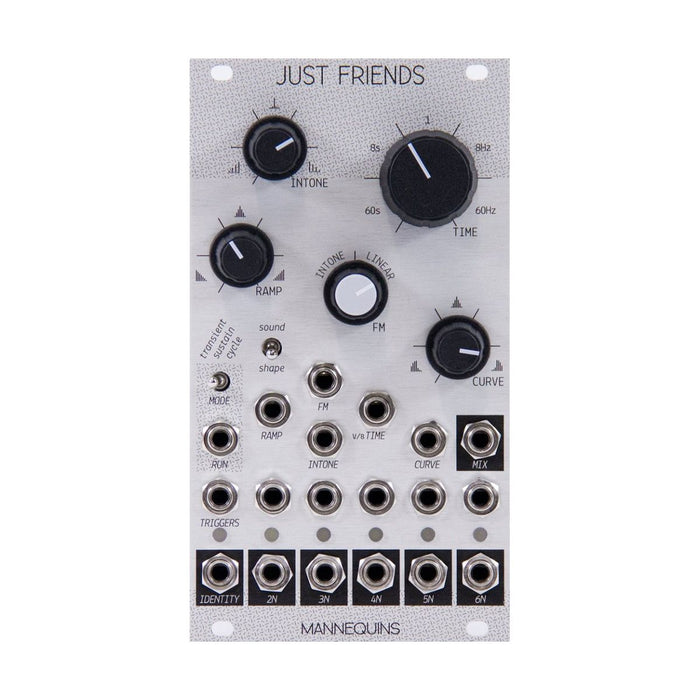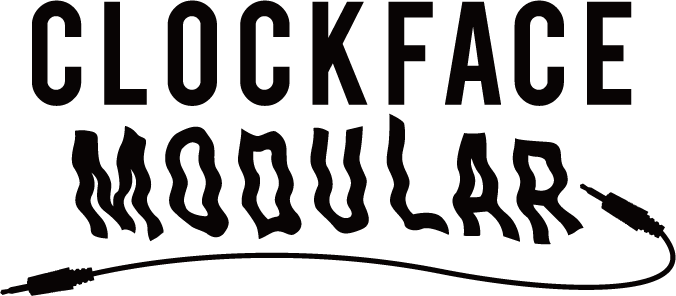Just Friends is a polyphonic slope generator that can generate six voltage flows at the same time. The output slope can be used as an envelope, LFO, or oscillator by switching the range of time and voltage that operates globally. Each output can receive triggers and gates independently, but the waveform parameters (Ramp and Curve) are common, and the speed of the slope (determined by TIME and INTONE) moves with six related to each other.
The Sound/Shape switch changes the time and voltage range that operates. In Sound mode, the voltage is -5V to 5V at 1 second to 24kHz when cv is used, and the voltage is 0 to 8V at 4 seconds to 160Hz for CV use in Shape mode.
Another switch is the Transient/Sustain/Cycle switch that switches the mode of the waveform trigger. For each mode, you might want to use the following:
-
Polyphonic envelope (in Shape+Transient or Shape+Sustain mode): Transient mode launches the corresponding envelope once with a separate trigger input for each slope. All triggers received during envelope startup are ignored and not retriggered regardless of attack or decay. In Sustain mode, the envelope is sustained at a height of 100% while the input gate is ON, and then off before it is released.
The trigger input is internally connected to the left-hand input, making it easy to launch multiple envelopes at the same time. It is easy to use for polyphonic patches because the speed of the 6 output can be controlled in common. It can also be used for spectral processors with gain CVs for each band.
-
6 Output LFO (in Shape+Cycle mode): In Cycle mode, the attack→decay envelope is repeatedly an LFO, and the start of the LFO is reset by individual trigger inputs. Smoothly and boldly change the relevance between channels, from fading to clock divide
-
Harmonic oscillator that outputs up to 6th overtone (in Sound+Cycle mode):When in Cycle mode and in Sound mode, the waveform is repeated at the audio rate, so it becomes an oscillator. When the Intone is turned to the right full, six outputs become the first, second, and third times, respectively. When Intone is in the middle, all six become the same frequency, and it becomes a detuned unison by turning it a little left and right. Each trigger input is a cycle reset, so it becomes a hard sink input (glitch)
In addition to switching modes, unique features such as Intone, non-triggered nature, internal termination of trigger input, and Intone FM allow for very flexible control in each mode, expanding the possibilities for patching.
And
Run inputpatches add powerful features that vary from mode to mode, and go ahead with the following: Controls parameters specific to additional features on the CV to Run.
-
Shape/Transient (Shift: No Retriggertime Control) - During envelope rise, the time zone that is not retriggered is only a certain amount of time from the start of the envelope, and Run controls the point at the end of the envelope. (If run is not patched, it will not be retriggered until the end of the envelope, and will support Run=5V.)
-
Shape/Sustain (Strata: Sustain level control) Patching Run to make the envelope aDSR type and run controls the sustain level
-
Shape/Cycle (Volley: Control burst count) Patching Run causes each output to become a burst generator, and each output cycles as many times as set by Run each time it is triggered.
-
Sound/Transient (Spill: 2N or more retriggerable time controls) Each time the Identity ends the cycle, it triggers another slope. Controls the non-triggerable time zone as well as the Shift control.
-
Sound/Sustain (Plume: LPG Response Control) Each time a trigger is received, each output outputs the oscillator sound at Cycle and the gated sound with a simulated LPG. The characteristics of the sound decay and envelope reaction depend on the run
-
Sound/Cycle (Floom: FM modulator pitch control) The oscillator for each channel will be able to receive FM from a virtual secondary oscillator (modulator) provided separately. The FM attenuator becomes an index control. Run controls the frequency of the virtual oscillator in the range of 1/2 to 2 times the carrier oscillator (oscillator for each channel)





